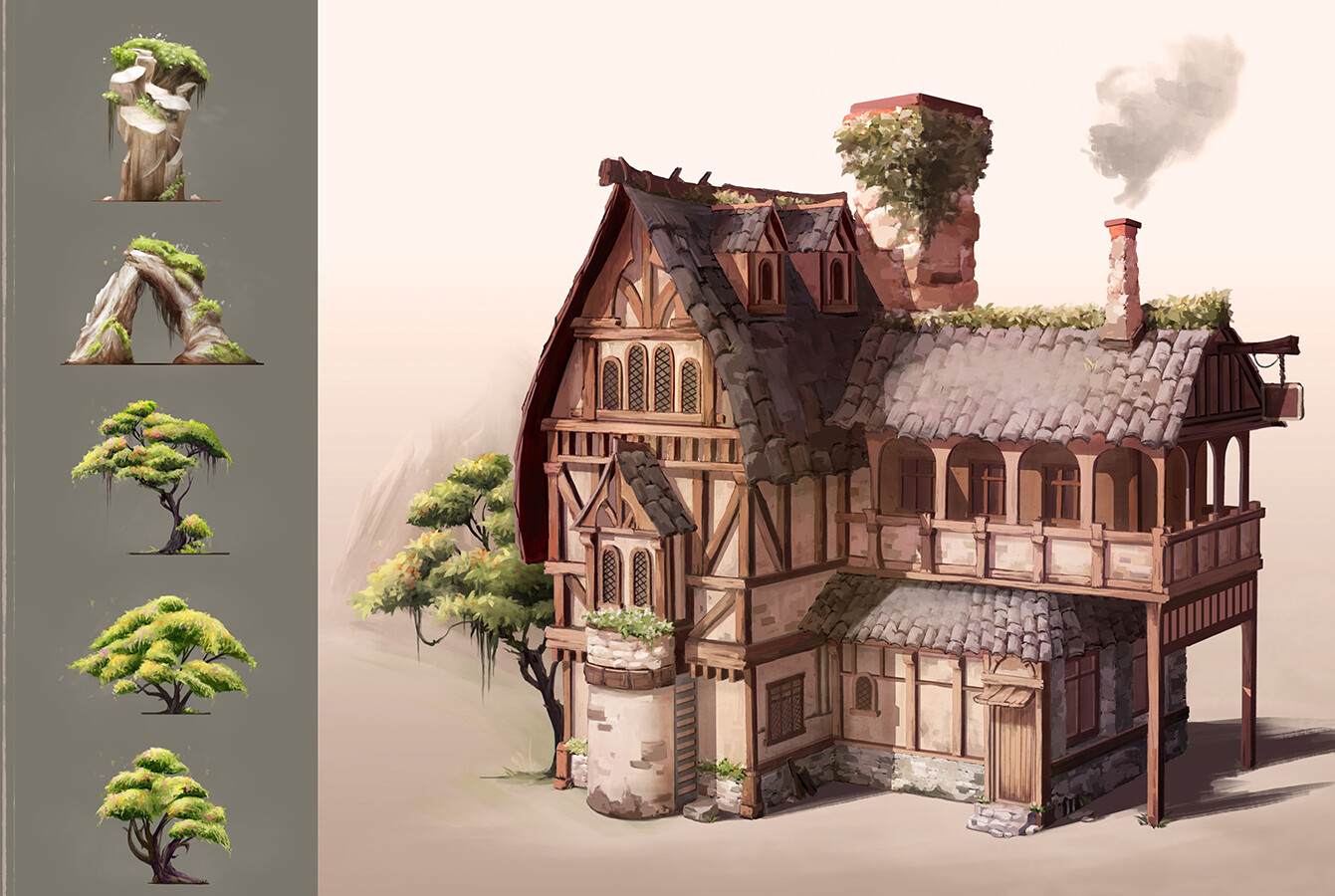Table Of Content

The outer shell was at times enhanced by a lower strengthening wall, called a chemise. These provided an excellent solution as the structure of the walls did not have to be very thick and heavy, which could have led to the collapse or sinking of parts of the mound or motte. Many hypothesis on the semantics of this exceptional format have been proposed, but still today, there are more questions than answers [24]. In most literature, it is presented as a ‘hunting’ castle, or part of a greater military defense chain of castles by Frederick II, but none of this hypothesis make sense in this totally isolated location on a ca. The next design step draws a double square, sided ½ 31 m, at the left and the right of the central longitudinal axis to create the overall entrance-temple area DEFG.
Medieval Castle Walls – Architecture & Elements
Medieval Castles were constructed in three different architectural phases, depending on the primary purpose of the castle and the necessity for a castle to be fortified as a stronghold against invaders. The four basic architectural styles–pre-Romanesque (motte-and-bailey), Romanesque (Norman castles), and Gothic–were the basis of castles built during the Medieval era, yet in some areas, they were changed according to the local architectural styles. For example, Germanic castles differed from British castles but kept the basic architectural designs.
Selected cases of ancient modulated design

Tudor buildings frequently combine dark wooden beams with white plaster or brick infill. The early medieval period was marked by motte-and-bailey castles which were mostly made from wood. The motte-and-bailey castles proved very effective military fortifications but they had the serious drawback of being prone to fire due to their wooden construction. Star forts, also called bastion forts, originated in Italy during the late 15th and early 16th centuries, during the French invasion of the Italian peninsula. This style enabled the construction of lower, thicker walls in the shape of a polygon. The angles of the bastion walls eliminated the so-called “dead zones” making cannonballs less likely to hit the target.
Shane Warne: Arcane Art
Further on, each of both composing squares get divided according golden mean ratio with the width of the lateral bay (with end-apse) as the ratios mayor and half of the central area as the ratios minor. The joining of both minors results in the central area along the common longitudinal axis of the ensemble. By this procedure, the entrance temple and the Rotunda get physical (through geometry and numbering) and spiritual (through various semantic) most intimately connected. The main elements of Medieval architecture can be divided into two basic categories, Romanesque and Gothic. The former is identifiable by its rounded arches, extremely thick walls, and minimal windows. On the other hand, pointed arches with plenty of windows and thinner walls (possibly supported by flying buttresses externally) are pointers to the Gothic style.
Graphic Design in the Middle Ages - new exhibition at The Getty - Medievalists.net
Graphic Design in the Middle Ages - new exhibition at The Getty.
Posted: Wed, 23 Aug 2023 07:00:00 GMT [source]
Romanesque
In this article, we will delve into the fascinating world of Tudor architecture, exploring its origins, key features, and notable examples that showcase the beauty of this timeless architectural style. From the 12th century onwards, medieval castles were typically more elaborate in their outlook and more militarily formidable. Nearly all notable castles from the 12th century to the end of the medieval period were made in stone.
What Is a Medieval-Style House?
While much of the surviving medieval architecture is either religious or military, examples of civic and even domestic architecture can be found throughout Europe. Examples include manor houses, town halls, almshouses and bridges, but also residential houses. Castles and fortified walls provide the most notable remaining non-religious examples of medieval architecture. Windows gained a cross-shape for more than decorative purposes, they provided a perfect fit for a crossbowman to safely shoot invaders from inside. Crenellated walls (battlements) provided shelters for archers on the roofs to hide behind when not shooting invaders.
Largely Ignored by the Western World, Africa's Medieval Treasures Shine at the Met - The New York Times
Largely Ignored by the Western World, Africa's Medieval Treasures Shine at the Met.
Posted: Thu, 16 Nov 2023 08:00:00 GMT [source]
As invasions from foreign lands increased, castle defense structures had to become more sophisticated. Ditches with double walls in concentric circles became a favored method to keep conquerors at bay. As building techniques advanced, castles were eventually built from blocks of hewn rock and bricks. Rapid advances in medieval technology, economy and the power of lords and monarchs allowed for the keeps of castles to be built by trained stonemasons under the supervision of a master mason. Most castles were initially built as fortifications, located on trade routes and along borders between countries. During the ancient Roman invasion of Europe, they had constructed fortifications in the same areas; these ruins were later frequently used as foundations for the new castles.

How long did it take to build a house in medieval times?
Medieval artists also incorporated diagrams to help readers grasp complex information.Information can be organized in a variety of ways, offering a valuable window into how medieval people visualized knowledge. These passages were intended to emphasize certain words or phrases, often to mark the beginnings and ends of text sections. Artists devised clever strategies for this purpose, leading to bold and varied designs. Construction began around 1070 on the ruins of the Temple of Claudius, commissioned by William the Conqueror. This original building was a single-story construction, the look Colchester takes today is thanks to an expansion around 1101.
While invaders were struggling to get over the ditches and climb the mounds, bowmen at the top had the perfect opportunity to shoot arrows directly at the invaders. We are a community of more than 103,000 authors and editors from 3,291 institutions spanning 160 countries, including Nobel Prize winners and some of the world’s most-cited researchers. Publishing on IntechOpen allows authors to earn citations and find new collaborators, meaning more people see your work not only from your own field of study, but from other related fields too. Los Angeles Times art critic Christopher Knight won the 2020 Pulitzer Prize for criticism (he was a finalist for the prize in 1991, 2001 and 2007). In 2020, he also received the Lifetime Achievement Award in Art Journalism from the Rabkin Foundation. Get our big stories about Hollywood, film, television, music, arts, culture and more right in your inbox as soon as they publish.
Whereas most types of rock shattered when hit, bricks were able to absorb the shock of artillery fire. In an effort to prevent invasion by tunneling under the corners, a system of thicker double-walled circles was built to surround the entire inner complex. Castles commissioned by Edward I in North Wales are excellent examples of this style, they remain strong to this day. Oftentimes, the suitable stone had to be transported a long way from quarries to the building sites. Additionally, roads often had to be built to transport these heavy stone blocks which added to the time, labor force, and expenses. These more complicated buildings served as the most secure military fortifications, residences for royals and nobles, and a fortress for the villagers during attacks.
They built on imagery created by stories of castles once filled with laughter and music, now haunted by ghosts and ghouls from the past. Engineering marvels such as the innovation of flying buttresses gave architects the ability to build higher and grander stone and brick buildings. The stone constructions provided better protection in conflict, and against elements such as wind and storms, but the large rooms were often dark, dank, and cold.
Viking Longhouses are well-known constructions, and representative of Nordic construction the world over. Longhouses were elongated rectangular structures and were constructed mostly of timber frames with wattle and daub. The floor was made from beaten earth or flagged with stones and a turf roof was common.
It was specifically constructed as a piece of Romanesque architecture, and it served as a Benedictine abbey. There is also a historical reason why this particular structure has managed to survive as an important piece of architectural history to this day. It is characterized by its pointed design, and it developed between the late 12th and the 16th centuries. It would go on to be replaced by Renaissance architecture, but it experienced a lengthy period of popularity. Gothic architecture is especially known for its pointed arches alongside pointed rib vaults and flying buttresses. This was developed alongside a dedication to stained glass windows, spires, and towers.
This particular location can be found in England, and it serves as the seat of the Bishop of Bath and Wells. It is an immensely important piece of Medieval architecture in this region, and an important religious site to this day because of its central place within the Anglican faith. It had once been a different church entirely, but starting from 1175, a Roman Catholic cathedral was built over it. A westwork was a specifically west-facing entrance design that was used in several types of Medieval architecture, including the Carolingian variety.
Jacobean buildings are characterized by a move towards more classical influences, using columns, pilasters, and symmetrical façades. The Hardwick Hallin Derbyshire showcases Jacobean Tudor architecture, featuring a stunning use of stone-mullioned windows and a balanced design. Shell keep castles were the improved defense system of the twelfth and thirteenth centuries. The original wooden surround on top of the motte was now enclosed by a hewn rock wall to provide a shell as an extra layer of protection.

No comments:
Post a Comment